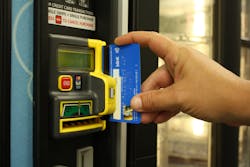5 Technologies That Can Drive Profits In Vending, Micro Markets
Technology is an expansive topic. When it comes to integrating technology into a vending, micro market and OCS operation, there are many bases to cover from backend support to point-of-sale offerings. And with so much technology on the market, it can be daunting to know what to invest in and when. Five technologies stand out, however, and each has in one way or another helped vending operations increase profits.
Vending management system
A vending management system (VMS) is a vital part of creating efficiencies within a vending company. A VMS helps manage commissions, streamlines a warehouse, provides cash accountability and aids with other back office tasks. With a VMS route drivers can use handhelds that offer the ability to track item level sales by machine. It also allows an operation to prekit, essentially eliminating a rolling warehouse. Port Huron, MI-based All Star Services found that prekitting with a pick-to-light system took about one third the time versus picking from paper, Automatic Merchandiser reported. Additionally, volume went up on a per-route level and drivers were servicing fewer machines per day.
The connected machine
For operators who want even more precise, real-time information, telemetry is a viable choice. Telemetry allows operations to connect directly with the machine in real-time, meaning that if a machine goes down, the operator knows and can solve the issue right away, rather than waiting for a call from the client. Real-time information also allows operations to help schedule machines and routes, meaning reduced drive time, vehicle load and even the number of routes operated. Telemetry technology lowered operating expenses 25 percent for Houston, TX-based Rome Refreshments. Company executives were then able to spend more time seeing customers face-to-face and grow in other segments.
Cashless, mobile payment
According to the State of the Vending Industry report, last year 57.6 percent of operators added at least one debit/credit card reader; however, only 11 percent of machines in the U.S. are equipped with cashless readers. Despite this, cashless is a growing segment in vending and micro markets and the ability to offer all payment types consumers are requesting is important for those operators looking for a competitive edge. In 2015, Five Star Food Service, located in Chattanooga, TN, implemented cashless card readers on 10,000 machines and on average saw same store sales increase by 17 percent and 24 percent after a “Go Cashless” campaign was launched. Cashless allows operators to sell higher ticket items and drive a higher margin but it also alleviates some price sensitivity. Just over 10 percent of operators added at least one mobile payment solution, the report found, but that number is expected to grow.
Online presence
Having an online presence is essential in the age of connectivity. According to the Small Business Administration, 97 percent of consumers look online for local products and services and 70 percent of smartphone owners have connected with a local business after a search. But it’s not just about creating a Website; it’s all about what the Website offers and how a customer can interact with it. In 2009 Madison, WI-based Capital Coffee began using an online ordering service and in six years grew the service so that 65 percent of its sales come directly from online purchases through its Website. Websites can also be lead-generators, too. Operators can create Website-specific content, such as blogs, which require a reader to fill out their email address before they get to view the content.
Digital signage
Digital signage is a great way to deliver targeted messages to consumers in a workplace setting. Operators can use digital signage to display advertisements, showcase new products and introduce new promotions. In both vending and micro markets, there is an opportunity for manufacturers to pay operators to run ads on the machine or kiosk’s digital signage; and there’s a local opportunity, too. Operators can work with local businesses such as car dealerships to advertise on the digital signage provided in the breakroom. Springfield, OH-based Sheehan Brothers Vending believed in the importance of digital signage when it invested in the product in 2014. The company decided to add media boards into its markets to promote specials and because it fell in line with the image of contemporary cafes.
Integrating technology will be an ongoing project but one that is invaluable to the success of vending, micro market and OCS operations.
About the Author

Adrienne Klein
Contributing Editor
Adrienne Zimmer Klein is a freelance writer with a background in the vending, micro market and office coffee service industry. She worked as an associate editor and managing editor at Automatic Merchandiser and VendingMarketWatch.com from 2013 until 2017. She is a regular contributing writer at Automatic Merchandiser.
